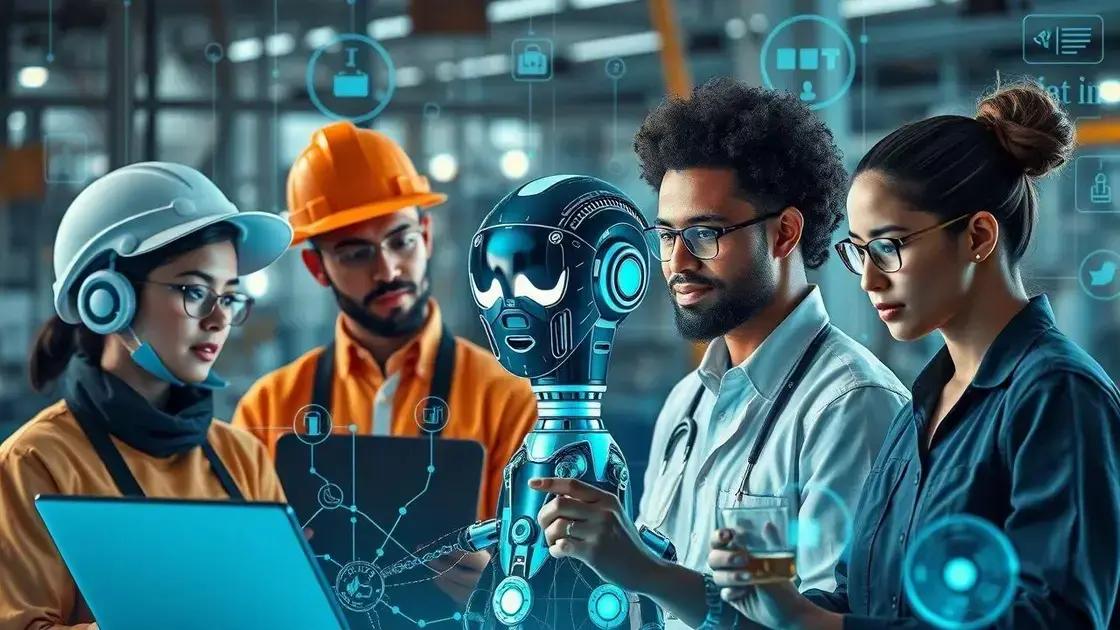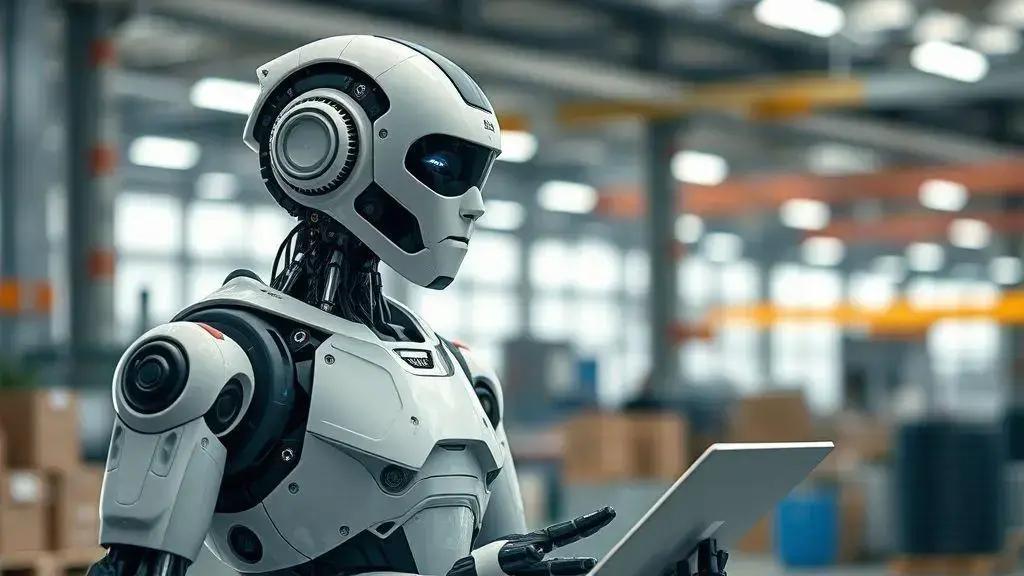Rise of humanoid robotics in American logistics
The rise of humanoid robotics in American logistics enhances efficiency, improves safety, and transforms workforce dynamics by automating tasks while creating new job opportunities in robot management and collaboration.
Rise of humanoid robotics in American logistics is changing how goods move across our country. Can you imagine a warehouse where robots and humans work side by side? This technology is not just futuristic; it’s here, shaping the logistics landscape.
Advancements in robotics technology
Advancements in robotics technology have significantly impacted various industries, especially logistics. These innovations are not just about automating tasks; they are about enhancing precision and efficiency.
Key Technologies Transforming Robotics
One of the core elements driving the rise of humanoid robotics is the advancement in artificial intelligence and machine learning. These technologies enable robots to learn from their environments, adapt to challenges, and make decisions autonomously. This evolution is crucial in logistics, where the ability to navigate complex settings can lead to substantial improvements in productivity.
- AI Algorithms: Enhance decision-making capabilities in real-time.
- Sensor Technologies: Allow robots to perceive their surroundings accurately.
- Machine Learning: Provides continuous improvement through experience.
- Collaborative Robots (Cobots): Designed to work alongside human workers safely.
By integrating these advancements, robotics technology is reshaping how goods are handled. For instance, automated guided vehicles (AGVs) can transport packages efficiently in warehouses, minimizing human error.
Future Possibilities of Robotics
As robotics technology continues to advance, the future of humanoid robotics in logistics looks promising. The trend leans towards more flexible robots that can perform various tasks. Such robots can adapt to different operational requirements, making them invaluable assets in logistics.
The introduction of 5G technology is also a game-changer. With faster communication speeds, robots can respond to commands more swiftly and operate in sync with other machines. This interconnectedness leads to improved efficiency and safety in logistics operations.
In conclusion, the advancements in robotics technology are opening new doors in the logistics world. With each innovation, we move closer to a future where robots and humans work hand in hand, optimizing operations and increasing overall productivity.
Impact on workforce dynamics

The impact on workforce dynamics from the rise of humanoid robotics in logistics is profound. As robots take on more tasks, the roles of human workers are also evolving. This shift creates both challenges and opportunities for employees in the industry.
Changing Roles in the Workplace
With the introduction of robots, many manual tasks are automated, which can lead to job displacement. However, this also means humans can focus on more complex and strategic roles. Workers are now required to have skills in managing and collaborating with robotic systems.
- Upskilling is essential: Workers need training in new technologies.
- Collaboration with robots: Human and machine teamwork is becoming the norm.
- Focus on creativity: Humans can concentrate on problem-solving and innovation.
- Job creation: New roles such as robot maintenance and programming are emerging.
The evolving workplace emphasizes the necessity for continuous learning. Workers who embrace new skills can find themselves in demand as the logistics industry adapts. This dynamic requires a shift in how companies approach workforce development.
Implications for Job Security
While some fear that robots will replace jobs, it’s important to recognize that they are tools designed to enhance productivity. The presence of humanoid robots can lead to safer working environments by taking over dangerous tasks. This change can help reduce workplace injuries while allowing human workers to engage in more critical activities.
Moreover, the integration of robots can lead companies to expand operations, resulting in more employment opportunities. Staff who learn to work alongside these machines will likely find increased job security in a tech-driven environment.
Understanding the impact on workforce dynamics is crucial as the logistics sector continues to evolve. By focusing on collaboration and continuous education, workers can thrive alongside emerging technologies.
Real-world applications in logistics
The real-world applications of humanoid robotics in logistics are transforming the industry in exciting ways. Companies are integrating these advanced robots into their operations to improve efficiency and accuracy.
Warehouse Automation
In modern warehouses, humanoid robots are used for tasks such as sorting, packing, and transporting goods. These robots work alongside human workers, uplifting their productivity. This collaboration allows human employees to focus on more complex tasks that require critical thinking and creativity.
- Improved efficiency: Robots can work continuously without breaks.
- Increased accuracy: Automated systems minimize human error.
- Faster operations: Tasks are completed at a quicker pace.
- Safe handling: Robots can manage heavy and hazardous materials safely.
By using humanoid robotics, companies can drastically reduce operating costs while enhancing the speed of their logistics processes. Automation is not just a trend; it is becoming a necessity for competitive advantage.
Last-Mile Delivery Solutions
Humanoid robots are also making their mark in last-mile delivery, which is a critical aspect of logistics. These robots can navigate urban environments and deliver packages directly to customers’ doorsteps. This innovation addresses the growing demand for fast and reliable deliveries.
Additionally, using robots for last-mile delivery can reduce traffic congestion and lower carbon emissions. Their ability to operate autonomously means they can choose the most efficient routes, resulting in quicker service with minimal environmental impact. This approach aligns with sustainability initiatives that many companies are now pursuing.
The integration of humanoid robotics in logistics enhances operational efficiency and enables companies to meet evolving customer expectations. With the potential for innovative delivery methods and increased productivity, the future looks promising for robotics in the logistics industry.
Future trends and challenges

The future trends in humanoid robotics within logistics promise exciting advancements. As technology continues to evolve, we can expect even more seamless integration of robots into logistics operations. Enhanced capabilities in artificial intelligence and machine learning will drive these changes.
Technological Integration
One major trend is the increasing connectivity of humanoid robots through the Internet of Things (IoT). By connecting robots to a network, they can share data and insights in real-time. This capability provides significant operational advantages. Robots can adjust their tasks based on real-time data, leading to improved efficiency and productivity.
- Data-driven decisions: Robots can analyze data to optimize performance.
- Remote monitoring: Operators can manage robots from anywhere.
- Collaboration with AI: Enhanced decision-making through smart algorithms.
- Predictive maintenance: Identifying potential issues before they cause downtime.
Another trend is the growing focus on sustainability. Businesses are increasingly looking for ways to reduce their carbon footprints, and humanoid robots can play a significant role in this effort. By optimizing routes and improving logistics processes, these robots can help companies meet their sustainability goals.
Challenges Ahead
However, the rise of humanoid robotics also brings challenges that need to be addressed. One significant issue is the required investment. Integrating advanced robotics into logistics systems can be costly, and not all businesses may have the resources to implement these technologies.
Moreover, workforce concerns persist. As robots take on more tasks, there is a fear of job displacement among human workers. Companies must navigate these challenges carefully to ensure a balanced approach that includes upskilling and retraining workers to collaborate effectively with robots.
Finally, cybersecurity threats also pose a significant challenge. As robots become more connected to networks, they may be vulnerable to hacking and cyberattacks. Businesses must prioritize security measures to protect their systems and data as they embrace these technologies.
FAQ – Frequently Asked Questions about Humanoid Robotics in American Logistics
How do humanoid robots improve logistics operations?
Humanoid robots enhance logistics by automating tasks, improving efficiency, and increasing accuracy in sorting and delivery.
What are the potential job impacts of humanoid robotics?
While some jobs may be displaced, new roles focusing on robot management and collaboration will emerge, requiring upskilling for the workforce.
How do humanoid robots contribute to workplace safety?
Humanoid robots can handle dangerous tasks, reducing the risk of injuries for human workers and creating a safer work environment.
What challenges do businesses face when integrating humanoid robots?
Businesses must navigate investment costs, workforce dynamics, and cybersecurity risks as they adopt humanoid robotics in their operations.





